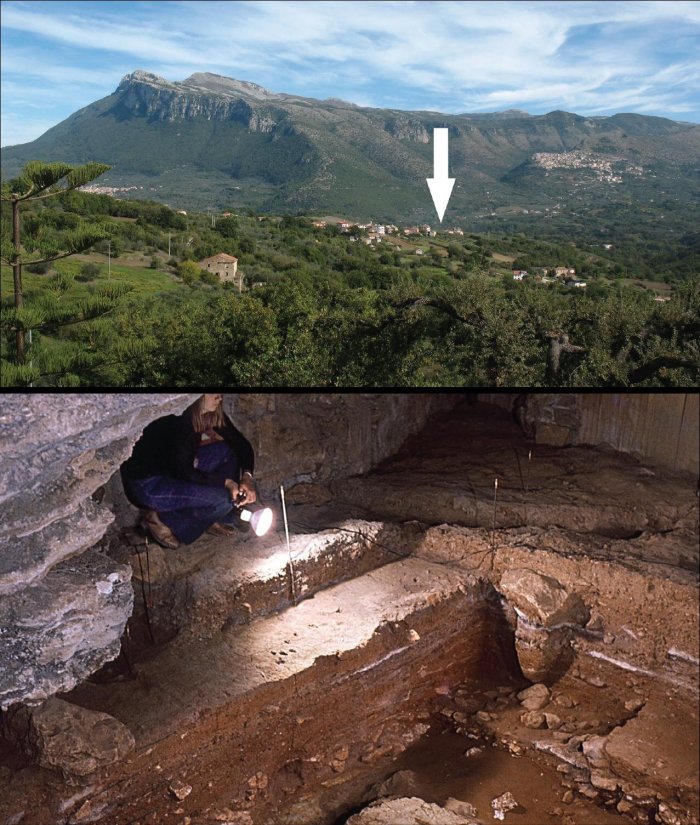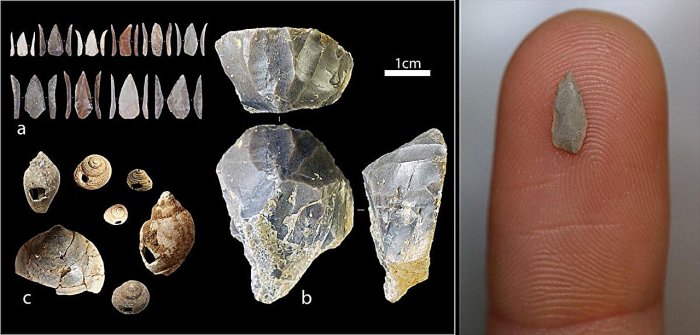Conny Waters – AncientPages.com – An international research team comprising scholars from the Universities of Tübingen, Siena, and Bologna conducted an analysis of cultural artifacts left by early Homo sapiens populations at Grotta di Castelcivita, located in southern Italy.
The research team included Dr. Armando Falcucci from the University of Tübingen.
Grotta di Castelcivita. Top: The location of the cave (indicated by a white arrow) at the base of the Alburni massif in the Campania region, southern Italy. Bottom: The excavation trench of the Upper Paleolithic layers. Credit: University of Tübingen
This explosive event, originating in the still-active Phlegraean Fields about 40,000 years ago, is considered the most powerful volcanic eruption ever recorded in the Mediterranean. Crucially, Grotta di Castelcivita is one of the rare archaeological sites where volcanic ash has sealed a high-resolution archaeological sequence.
This cataclysmic event, originating in the still-active Phlegraean Fields about 40,000 years ago, is widely acknowledged as the most potent volcanic eruption documented within the Mediterranean region. Of particular significance is the Grotta di Castelcivita, which stands as one of the few archaeological sites where volcanic ash has effectively preserved a high-resolution archaeological sequence.
Examples of material culture remains discovered in the uppermost layers of Grotta di Castelcivita, before the definitive sealing of the archaeological sequence by the volcanic eruption. The micro-points (a) were extracted from cores (b) that bear the negatives of these removals. In addition to stone tools, over a hundred marine shells of different species were collected from the Mediterranean shores and perforated for decorative purposes (c). On the right, one of the micro-points is shown on top of a fingertip. Credit: University of Tübingen
This unique circumstance provides invaluable data for scientific analysis and historical interpretation.
Researchers reconstructed stone tool-making methods to show that cultural development at Castelcivita occurred before the deposition of the volcanic layers and the Heinrich Stadial 4 cold climate phase, which lasted about 2,000 years.
The archaeological site has yielded evidence of a significant cultural advancement, specifically manufacturing miniature stone points. These artifacts were fabricated from lithic materials sourced close to the cave and selected for their optimal fracture characteristics.
It is hypothesized that these micro-tools were designed for integration into composite projectile weaponry.
This discovery has the potential to significantly shift our understanding of human prehistory by challenging long-held speculations that natural disasters, such as volcanic eruptions and cooling events, were crucial drivers of major changes in the lifeways of hunter-gatherers.
The study, publishedin Scientific Reports, suggests that cultural innovations in early Homo sapiens stemmed from cultural transmission mechanisms and the formation of large-scale networks extending beyond the Alps.
The reserch is of great value because it advances our understanding of Upper Paleolithic hunter-gatherers’ adaptive strategies in changing environments.
Grotta di Castelcivita is a crucial European prehistoric site, featuring a detailed stratigraphic sequence showing Neanderthals’ replacement by early Homo sapiens around 43, 000 years ago.
Excavations and research here are conducted by the University of Siena’s Research Unit of Prehistory and Anthropology, with permission from the Italian Ministry of Culture. Adriana Moroni directs the project.
Paper:
Armando Falcucci et al, A pre-Campanian Ignimbrite techno-cultural shift in the Aurignacian sequence of Grotta di Castelcivita, southern Italy, Scientific Reports (2024). DOI: 10.1038/s41598-024-59896-6
Written by Conny Waters – AncientPages.com Staff Writer






Recent Comments